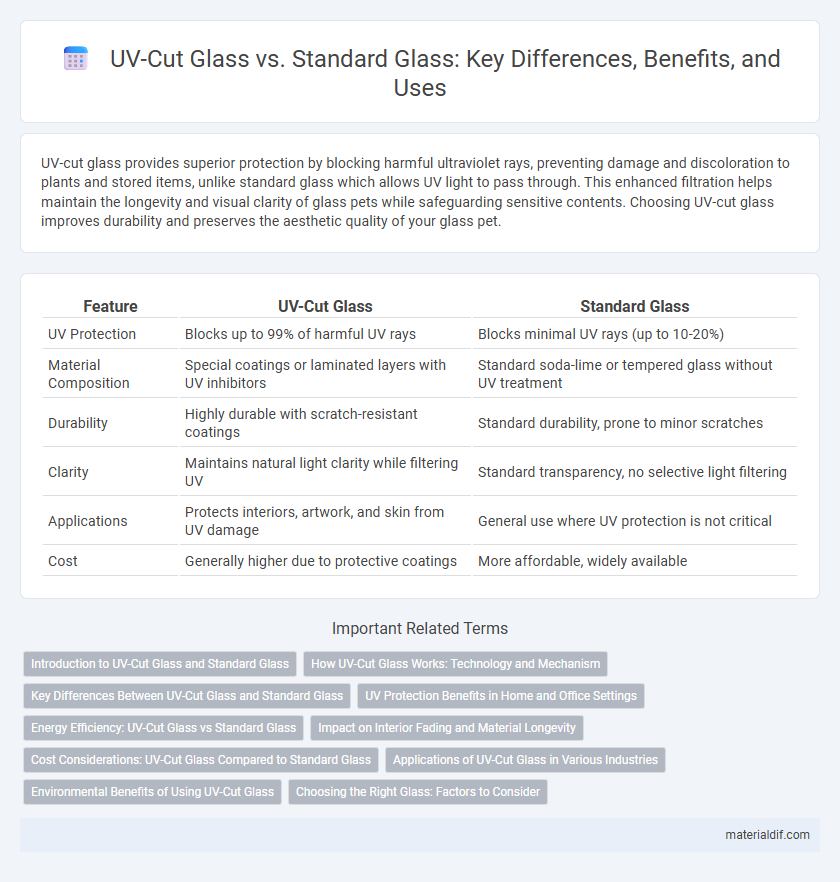UV-cut glass provides superior protection by blocking harmful ultraviolet rays, preventing damage and discoloration to plants and stored items, unlike standard glass which allows UV light to pass through. This enhanced filtration helps maintain the longevity and visual clarity of glass pets while safeguarding sensitive contents. Choosing UV-cut glass improves durability and preserves the aesthetic quality of your glass pet.
Table of Comparison
| Feature | UV-Cut Glass | Standard Glass |
|---|---|---|
| UV Protection | Blocks up to 99% of harmful UV rays | Blocks minimal UV rays (up to 10-20%) |
| Material Composition | Special coatings or laminated layers with UV inhibitors | Standard soda-lime or tempered glass without UV treatment |
| Durability | Highly durable with scratch-resistant coatings | Standard durability, prone to minor scratches |
| Clarity | Maintains natural light clarity while filtering UV | Standard transparency, no selective light filtering |
| Applications | Protects interiors, artwork, and skin from UV damage | General use where UV protection is not critical |
| Cost | Generally higher due to protective coatings | More affordable, widely available |
Introduction to UV-Cut Glass and Standard Glass
UV-cut glass integrates a special coating or interlayer designed to block up to 99% of ultraviolet (UV) radiation, protecting interiors from harmful UV rays and reducing fading of furnishings. Standard glass typically allows most UV light to pass through, offering minimal protection against UV damage and contributing to heat buildup. The advanced technology in UV-cut glass enhances durability and energy efficiency compared to conventional glass products.
How UV-Cut Glass Works: Technology and Mechanism
UV-cut glass incorporates a special coating or interlayer embedded with ultraviolet (UV) absorbers that effectively block UV rays while allowing visible light to pass through. The technology relies on materials such as titanium dioxide or UV-absorbing polymers that absorb or reflect UV radiation, preventing it from penetrating indoor spaces. This mechanism reduces harmful UV exposure, protects furnishings from fading, and enhances occupant comfort compared to standard glass, which offers minimal UV protection.
Key Differences Between UV-Cut Glass and Standard Glass
UV-cut glass blocks up to 99% of harmful ultraviolet (UV) rays, protecting interiors from fading and reducing skin damage, whereas standard glass typically filters only a small fraction of UV radiation. The specialized coatings on UV-cut glass enhance energy efficiency by minimizing heat transfer, unlike standard glass which allows higher UV penetration and heat gain. This makes UV-cut glass ideal for applications requiring improved UV protection, such as in automotive windows, skylights, and display cases.
UV Protection Benefits in Home and Office Settings
UV-cut glass blocks up to 99% of harmful ultraviolet rays, significantly reducing skin damage and fading of interior furnishings compared to standard glass. This enhanced UV protection helps preserve furniture, flooring, and artwork from discoloration and deterioration while promoting healthier indoor environments in homes and offices. Investing in UV-cut glass also contributes to energy efficiency by minimizing heat buildup caused by UV radiation.
Energy Efficiency: UV-Cut Glass vs Standard Glass
UV-cut glass significantly enhances energy efficiency by blocking up to 99% of harmful ultraviolet rays, reducing heat transfer and minimizing indoor temperature fluctuations compared to standard glass. This reduction in solar heat gain decreases the need for air conditioning, leading to lower energy consumption and utility costs. Standard glass allows more UV radiation and heat penetration, resulting in higher cooling demands and less effective thermal insulation.
Impact on Interior Fading and Material Longevity
UV-cut glass significantly reduces interior fading by blocking up to 99% of harmful ultraviolet rays, protecting furniture, fabrics, and artwork from color deterioration and material breakdown. Standard glass allows much higher UV transmission, accelerating the fading process and degrading interior materials over time. The enhanced UV protection in UV-cut glass also extends the longevity of interior surfaces and finishes, preserving their appearance and structural integrity longer than standard glass.
Cost Considerations: UV-Cut Glass Compared to Standard Glass
UV-cut glass typically costs 20-30% more than standard glass due to advanced coatings or embedded nanoparticles that block ultraviolet rays effectively. While the initial investment is higher, UV-cut glass reduces interior fading and lowers cooling expenses by minimizing solar heat gain, potentially offsetting extra costs over time. Standard glass lacks UV protection, leading to increased maintenance and replacement costs for furniture and materials exposed to sunlight.
Applications of UV-Cut Glass in Various Industries
UV-cut glass is widely used in industries such as automotive, electronics, and architecture due to its ability to block harmful ultraviolet rays while maintaining transparency. In healthcare and museum sectors, UV-cut glass protects sensitive materials and artwork from UV-induced degradation, extending their longevity. This specialized glass enhances energy efficiency and user comfort in residential and commercial buildings by reducing heat and glare without compromising natural light.
Environmental Benefits of Using UV-Cut Glass
UV-cut glass significantly reduces harmful ultraviolet (UV) radiation transmission, decreasing indoor fading of furniture and materials, thereby extending their lifespan and reducing waste. By limiting UV exposure, this glass also lowers the need for artificial cooling, contributing to energy savings and reduced carbon emissions. Its ability to protect interiors from UV damage promotes sustainability by minimizing replacement frequency and conserving resources.
Choosing the Right Glass: Factors to Consider
When choosing between UV-cut glass and standard glass, consider factors like UV protection levels, energy efficiency, and long-term durability. UV-cut glass blocks up to 99% of harmful ultraviolet rays, reducing interior fading and protecting skin, whereas standard glass allows more UV penetration. Evaluate the specific application, climate conditions, and budget to ensure optimal comfort and sustainability.
UV-cut glass vs Standard glass Infographic

 materialdif.com
materialdif.com